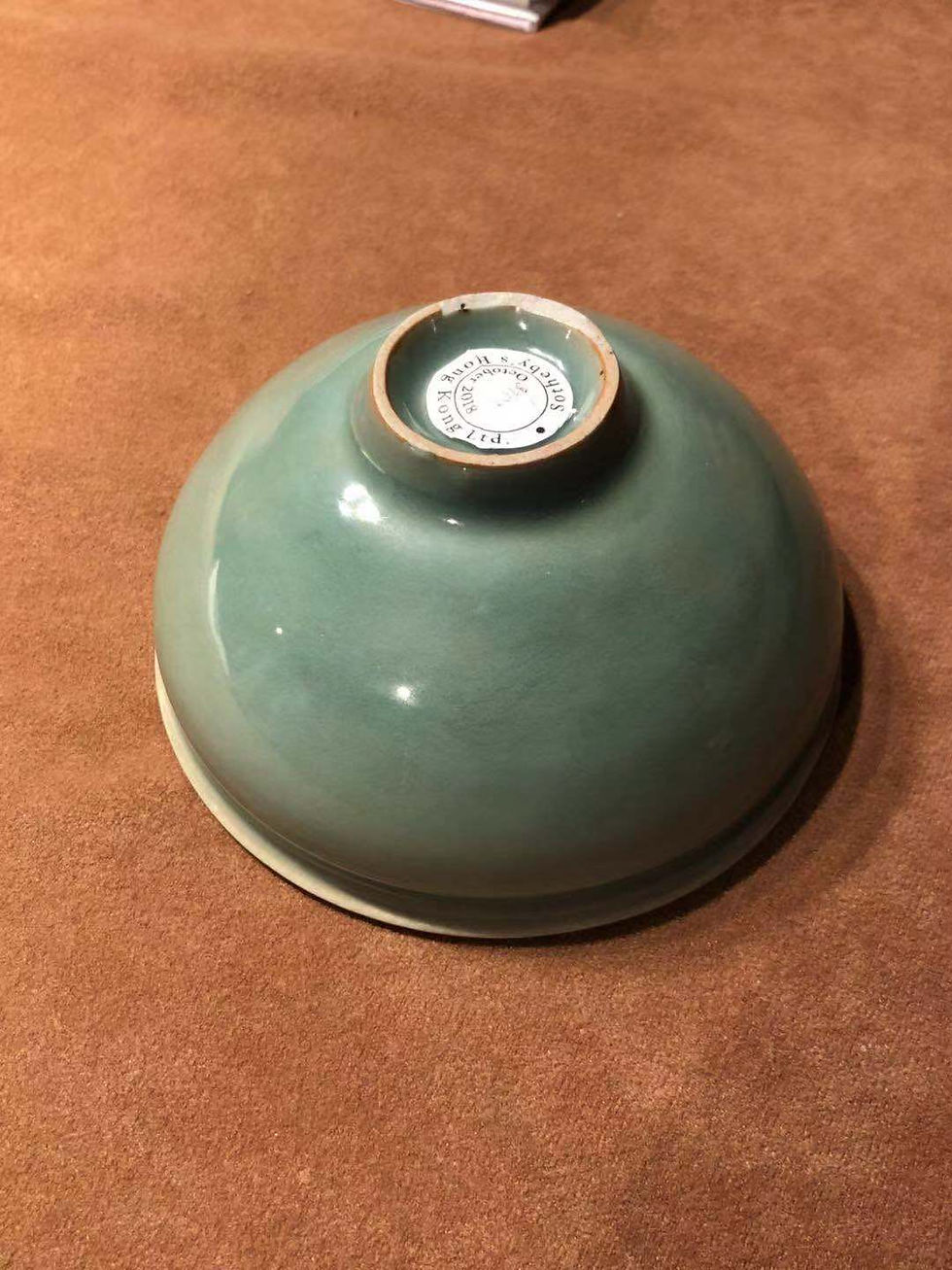宋代筆記 Vol.90 傳世237.5萬港元南宋龍泉窯束口茶碗:波士頓美術館展覽,顯赫西方藏家遞藏 - Heirloom Longquan Teabowl: MFA, Komor, Batz, Rodriguez Collection.
- SACA
- Oct 2, 2024
- 4 min read
Updated: Oct 10, 2024
這件典型的龍泉窯傳世作品是同類中的上乘之作,主要原因有:1、釉色翠綠明亮;2、釉層溫厚潤澤;3、造型線條飽滿柔美;4、束口處積釉靈動深邃;5、傳世、眾多明星藏家收藏;6、1953年美國波士頓美術館展覽記錄。
2018年9月在香港蘇富比拍得港幣237.5萬,創同類器型價格的世界紀錄。如今時隔6年回看,龍泉窯傳世作品的價格已經上漲不少,近日一件區百齡的龍泉窯花口洗在香港佳士得拍出超過300萬港元的價格。相信這件器物若重新上拍,將會創造更高的世界紀錄,引領全球中國藝術愛好者、藏家的認知。
這件器物在2011年3月23日紐約蘇富比曾經上拍,估價3-5萬美金,成交價為12.25萬美金;2018年9月蘇富比上拍,估價1,800,000 — 2,200,000港元 (229,320 - 280,280美金),成交價為237.5萬港元,約31萬美金。7年間價格上漲約3倍。
This typical Longquan kiln heirloom piece is the finest of its kind for the following reasons:
1) bright emerald-green glaze; 2) warm and subtle glaze tone; 3) elegantly shaped and potted; 4) dynamic glaze distribution at the mouth rim; 5) heirloom and numerous celebrity collectors' collections; and 6) record of an exhibition at the Boston Museum of Art, USA, in 1953.
In September 2018, it fetched HK$2,375,000 at Sotheby's Hong Kong, setting a world record price for the same type of vessel. Six years later, the price of Longquan kiln heirloom works has risen substantially, recently an Au Bai Ling Longquan dish in Hong Kong Christie's fetched more than 3 million Hong Kong dollars. It is believed that this piece, if re-auctioned, will set an even higher world record.
It was previously auctioned at Sotheby's New York on 23 March 2011, with an estimate of $30,000 - $50,000, and sold for $122,500; and at Sotheby's in September 2018, with an estimate of HK$1,800,000 - 2,200,000 ($229,320 - $280,280), it sold for HK$2,375,000, or approximately $310,000. The price has risen approximately threefold in seven years.
Lot 3103. An extremely rare heirloom Longquan celadon bowl, Southern Song dynasty (1127-1279)
11.3 cm, 4 3/8 in.
Estimate 1,800,000 — 2,200,000 HKD (229,320 - 280,280 USD)
Lot Sold 2,375,000 HKD (302,955 USD)
superbly potted with generously rounded sides rising from a narrow, slightly tapered foot to a softly grooved band below the crisp and gently flared rim, covered overall save for the unglazed footring with a lustrous translucent glaze of soft blue-green tone.
Provenance: Mathias Komor, New York, 1952.The Georges de Batz Collection, no. 75 (label).Christie's New York, 30th November 1983, lot 331.The Rodriguez collection (label).Christie's New York, 20th September 2005, lot 279.Sotheby's New York, 23rd March 2011, lot 506.
Exhibited: Chinese Ceramics and European Drawings from the Georges de Batz Collection, Museum of Fine Arts, Boston, 1953, no. 75.
Note: With its elegant form and unctuous glaze, the present bowl is a fine example of the high-Song taste for pure colour and understated refinement. Towards the end of the 12th century, the traditional lime glaze was replaced by a lime-alkali glaze, creating a higher viscosity and softer gloss. Multiple layers of glaze were often applied to capture a jade-like effect; a technique that was probably adopted from the Guan wares of the period. The glaze of the present bowl is a thick lustrous bluish green, often referred to as the kinuta glaze by the Japanese who were especially fond of these wares which were considered masterpieces of the Longquan potter.
A slightly smaller bowl of this type, excavated in 1974 at Quzhou, Zhejiang province, from the tomb of Shi Shengzu and his wife, dated to the 10th year of Xianchun (corresponding to 1274), is published in Dated Ceramics of the Song, Liao and Jin Periods, Beijing, 2004, pl. 6-19; and another, recovered from the Sinan ship wreck off the coast of Korea, was included in the Special Exhibition of Cultural Relics Found off the Sinan Coast, National Museum of Korea, Seoul, 1977, cat. no. 8. Further examples, all of slightly smaller size, include one from the collection of Sir Percival David and now in the British Museum, London, published in Illustrated Catalogue of Celadon Wares in the Percival David Foundation of Chinese Art, London, 1997, Revised Ed., pl. 252; one, previously from the Lord Cunliffe collection, included in the exhibition Heaven and Earth Seen Within. Song Ceramics from the Robert Barron Collection, New Orleans Museum of Art, New Orleans, 2000, cat. no. 59; another was exhibited in Song Dynasty Ceramics: The Ronald W. Longsdorf Collection, J.J. Lally & Co., New York, 2013, cat. no. 10; and a fourth bowl, from the Thomas Barlow Walker collection, was sold twice in our New York rooms, 26th September 1972, lot 682, and 23rd/24th May 1974, lot 321. See also another bowl, but with a broader groove, published in the Illustrated Catalogues of Tokyo National Museum. Chinese Ceramics, Tokyo, 1988, pl. 461.
The form of this bowl, with its gently grooved rim and short foot, may have been inspired by black Jian wares which were popular vessels in tea ceremonies; for example see a brown-splashed bowl in the National Palace Museum, Taipei, included in the Museum's exhibition The Far-Reaching Fragrance of Tea. The Art and Culture of Tea in Asia, Taipei, 2015, cat. no. I-14.

















記憶猶新,非常好的一件器物。